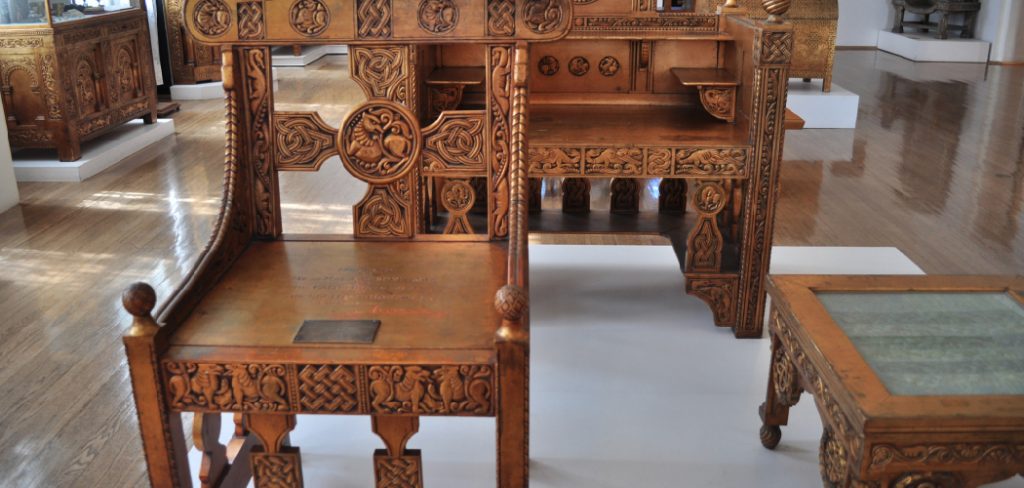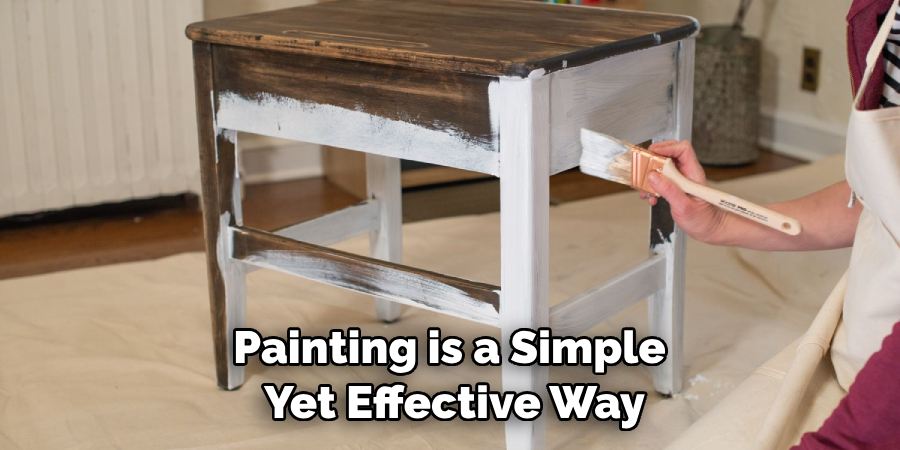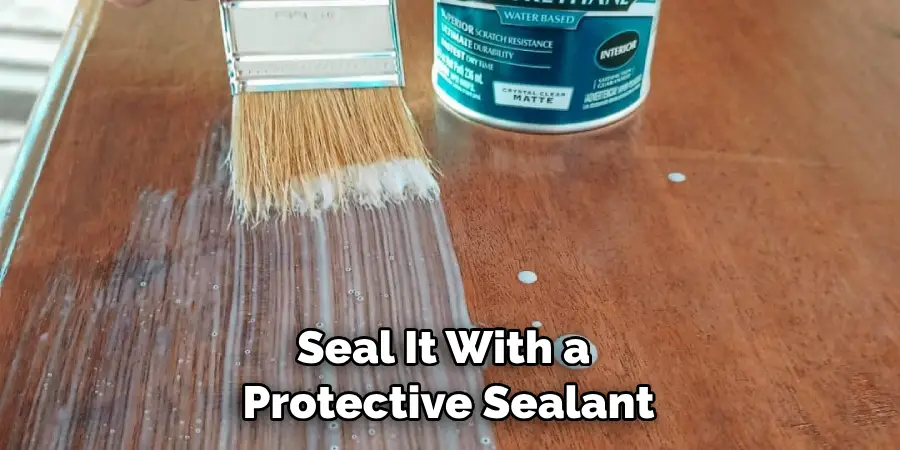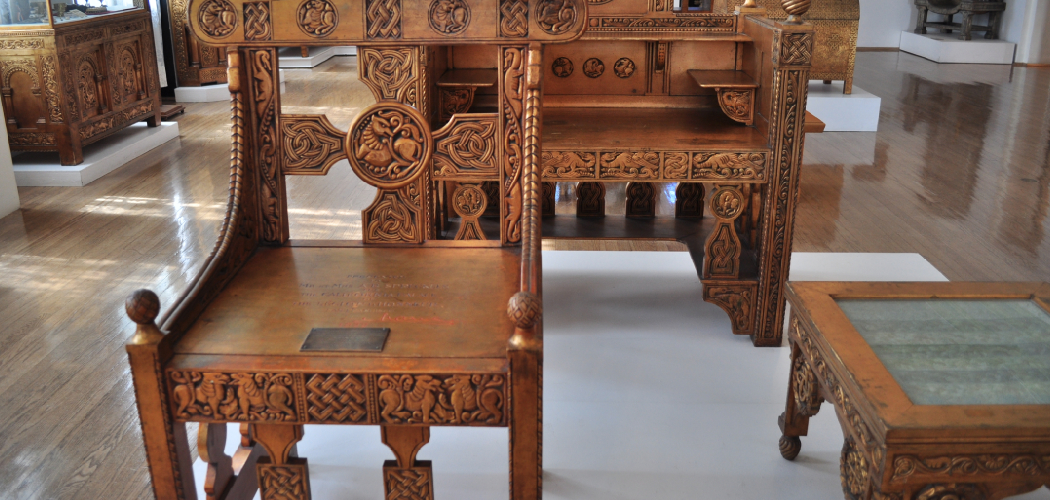If you want to revamp the look of your wooden furniture without breaking the bank, changing its color can be an excellent solution. Whether you want to darken the tone or give it a completely new color, there are different methods to achieve your desired results. In this blog post, we will explore some effective ways how to change color on wood furniture so that you can become a DIY pro in no time.

Can You Change the Color of The Wood Furniture?
Wood furniture can be a beautiful addition to any home, but what if the color of the wood no longer matches the decor? The good news is it is possible to change the color of your wood furniture.
Whether you want to make the wood darker or lighter or even add a pop of color, various techniques and products are available to transform your furniture. The possibilities are endless, from sanding and staining to painting and using wood dyes. Don’t be afraid to experiment and give your furniture a fresh, new look that perfectly complements your style and taste.
Why Should You Change the Color of Wood Furniture?
Wood furniture is a staple in many homes, but have you ever considered changing the color of your beloved pieces? Adding a new hue to your furniture can completely transform the look and feel of a room. Maybe your wooden chair has seen better days and needs a fresh start, or you want to update the vibe of your living space.
Whatever the reason, a new color can make all the difference. Plus, painting or staining your furniture can be a fun DIY project that lets you put your personal touch on your home decor. So go ahead, take a chance, and add a pop of color to your wood furniture. You never know, it could be just the change you’ve been looking for!
Become a DIY Pro: How to Change Color on Wood Furniture
1. Sanding
Sanding is an excellent way to remove the existing finish on your wooden furniture so that you can apply a new one. Start by cleaning the furniture with a dry cloth and then use sandpaper to remove the top layer of the wood finish.

You can use a sanding block or an electric sander for larger pieces of furniture. Once you’ve sanded it down to the bare wood, you can apply your new stain or paint. Remember to always sand in the direction of the wood grain to prevent damage to the wood.
2. Bleaching
Bleaching can be a good option if you want to change the color of your wooden furniture completely. It works by stripping the natural color of the wood, making it easier for you to apply a new color. To bleach your furniture, you must use wood bleach, available at most hardware stores.
Mix the bleach with water according to the manufacturer’s instructions and apply it to the furniture. Once you’ve applied the bleach, please wait a few hours before rinsing it off with water. You can repeat the process until you’ve achieved the desired shade.
3. Staining
Staining is an effective way to change the color of your wooden furniture while still preserving the natural wood grain. Unlike painting, staining penetrates the wood and can darken the tone or give it a new color. Before staining, make sure the furniture is clean and sanded. Apply the stain with a brush or cloth, and cover all the areas evenly. Leave the stain to absorb for a few minutes before using a clean cloth to wipe away any excess.
4. Paint
Painting is a simple yet effective way of updating the look of your wooden furniture. Choose a paint specifically designed to adhere to wood surfaces and apply it evenly with a brush or roller. Allow it to dry before adding another coat. You can add a topcoat to protect the new layer of paint and give your furniture a polished finish.

5. Chalk paint
Chalk paint is ideal for a more rustic or shabby chic look on your furniture. You won’t need to sand your furniture, and chalk paint typically doesn’t require many coats. Chalk paint adheres well to most surfaces and dries quickly. You can use it to add texture to your furniture or distress it to make it look aged.
6. Glazing
Glazing is an effective way to add depth and texture to your furniture while still preserving its original color. You can use glaze to tint the wood or give it a new color lightly. Start by applying a thin layer of glaze with a brush, then use a cloth to wipe away any excess. Allow the glaze to dry before applying a topcoat for extra protection.
7. Waxing
Waxing is an easy way to give your furniture a polished look and protect it from daily wear and tear. Before waxing, make sure you’ve properly cleaned and sanded the wood surface. You can use either liquid or paste wax to create your desired finish, then apply it with a cloth or brush and buff the surface until it shines. Regularly waxing your furniture will help keep it looking like new for longer.
Now that you know how to change color on wood furniture, why don’t you try one of these methods and get creative? Changing the color of your wooden furniture can be a great way to give your home a whole new look without spending too much money. Have fun, and let your imagination run wild!
5 Considerations Things When You Need to Change Color on Wood Furniture
1. Prepare the Surface
The first step in changing the color of wood furniture is to prepare the surface. This involves sanding down any existing finish or paint and removing any dirt, dust, or debris from the surface. You can apply a new color once the surface is clean and free of any old finishes.

2. Choose Your Color
Once you’ve prepared the surface, it’s time to choose your color. You have many options for changing the color of wood furniture. You can choose from various stains, paints, and glazes that come in various colors and finishes. Consider how much light your room gets and what type of mood you want to create before deciding.
3. Apply Primer
Before applying a new color to your wood furniture, it’s important to use a primer first. Primer helps protect the wood from damage caused by moisture or UV rays and provides a more even base for your paint or stain to adhere to. Use a primer specifically designed on wood surfaces for best results.
4. Use Proper Application Techniques
Once you’ve chosen your color and applied primer, it’s time to apply the new finish or paint. Make sure you use proper application techniques, such as using long strokes with a brush or roller when painting and wiping off excess stains with a cloth when staining. This will ensure even coverage and help prevent streaks or other imperfections in your finished product.
5. Seal It Up
Finally, once you’ve finished applying your new finish or paint, seal it with a protective sealant such as varnish or polyurethane sealant. This will help protect your newly-painted piece from scratches and wear over time while also helping it last longer than if left unsealed.
5 Benefits of Change Color on Wood Furniture
1. Increased Aesthetic Appeal
One of the primary benefits of changing wood furniture color is that it can dramatically increase its aesthetic appeal. Changing the color of a piece of furniture can make it look more modern and stylish, allowing it to match the décor in your home better. Additionally, painting or staining a piece of furniture can help to hide any imperfections or damage that may have occurred over time.

2. Improved Durability
Changing the color of wood furniture can also improve its durability. Stains and paints are designed to protect the surface of the wood from scratches, dents, and other types of damage. Additionally, they can help to seal out moisture, which can cause warping and cracking in untreated wood over time.
3. Easy Maintenance
Another benefit of changing the color of wood furniture is that it is relatively easy to maintain. Stains and paints are designed to be long-lasting and durable, meaning they do not require frequent touch-ups or repairs like some other finishes may need. Additionally, many stains and paints are designed to resist spills and scratches, making them ideal for high-traffic areas in your home, such as kitchens and entryways.
4. Cost-Effective Option
Changing the color of wood furniture is also a cost-effective option than buying new pieces or replacing existing ones entirely. Painting or staining a piece of furniture is much less expensive than buying a new one, making it an ideal choice for those who want to update their home without breaking the bank.
5. Personalization Possibilities
Finally, changing the color of wood furniture offers countless possibilities for personalization and customization. With so many colors available, you can easily create a unique look for your home that reflects your style and taste. Additionally, you can experiment with different techniques, such as distressing or antiquing, to give your pieces an aged look that adds character and charm to any space in your home.
Conclusion
Changing the color of your wooden furniture is a cost-effective way to add a new look to your space. Whether you want to darken the tone or try out a completely new color, there are different methods to achieve your desired results.
We hope these tips have been informative and helpful in guiding you to become a DIY pro in no time. Remember to take your time and have fun with the process! Thanks for reading our post about how to change color on wood furniture.


